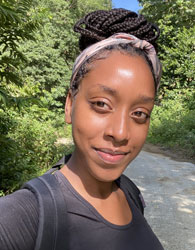Authors: (Left to right) Deborah Villarroel-Lamb, Simone Ganpat, Andrew Williams and Fadia Aziz




A team of researchers at The University of the West Indies, Trinidad and Tobago, are on a quest for an unrivalled ‘how-to-guide’ on building coastal resilience in Caribbean Small Island Developing States. Deborah Villarroel-Lamb, Simone Ganpat, Andrew Williams and Fadia Aziz, discuss their journey so far.
Caribbean Small Island Developing States (SIDS) make up one of the most diverse and unique regions in the world. Their unique and magnificent biogeographical history coupled with centuries of migration flows of human and non-human species have shaped an abundance of sociocultural, geopolitical and socioeconomic realities to date, all co-existing within the embrace of the Caribbean Sea. Despite such diversity, there are many common threads that define the experiences of Caribbean SIDS, especially in relation to the process of sustainable development.
Coastal zones are naturally diverse and exhibit some of these commonalities and can perhaps provide the critical answers we need in our pursuit of sustainable development in the face of global climate change. The coupling of marine and terrestrial ecosystems at the coast produces diverse ecotones such as mangrove forests; the site of first contact for global and regional trade creates investment opportunities; the concentration of investment and biodiversity gives people the impetus to settle; the concentration of people creates systems of culture, language and livelihood.
At the same time, the coast remains perpetually on the frontline of storm surges, sea level rise and coastal erosion, all of which are expected to increase in frequency and intensity due to accelerated climate change. Achieving resilience on the coastal zone stands to effectuate a multitude of savings and benefits, across systems, through networks and down generations.
Therefore, the question is not whether we should strive for coastal resilience, but rather how do we get there in the face of such high stakes and existential threats?
How do we reach the best outcomes for all?
Diversity presents a plethora of possibilities, but it also makes clear the complexities necessary to face. So, how do we know which approach is “best”? It might be easy to agree that a diverse landscape essentially calls for diversity in problem solving, but the process is often not that simple. To advance progress on complex problems, such as the impacts of climate change, we must transcend several boundaries; disciplinary, sectoral, physical, mental, etc, which undoubtedly can be a frictional and complicated process.
A transdisciplinary approach requires action. It challenges us to move beyond the confines of our disciplines, beyond basic contact between academics, practitioners and communities. It emphasises the practice of interconnectedness; reaching a place of sustained and genuine collaboration where the vision and the actors involved in its fruition are inextricable from each other.
But how do we realise such interconnectedness?
Rigolot (2020) puts forward the idea of transdisciplinarity as a way of being that becomes useful from acknowledging problems in everyday life as complex and recognising that the relevant skills and knowledge to overcome such complex problems have been developed and practiced throughout human history and far beyond academia. In short, transdisciplinarity can be seen as a practice of disposition. We can communicate what we have done, collate what has been done by others, identify similarities to address any challenges and elucidate opportunities through the process. We can find ways to have open and honest discourse about hopes, fears, goals and obstacles. We can embody the disposition of transdisciplinary; investing in the vision and willing to compromise to achieve the optimal outcomes for all.
State-of-the-art technologies and technical reports mean little to persons who are currently challenged with loss of livelihood, assets and natural resources due to coastal flooding and erosion.
On paper, this might seem relatively achievable. In real life, compromise is difficult when we are faced with pressing issues, especially as vulnerable coastal communities face the threat of the rapidly changing coast. State-of-the-art technologies and technical reports mean little to persons who are currently challenged with loss of livelihood, assets and natural resources due to coastal flooding and erosion.
What do sustainable solutions look like?
The vision of the Sustainable Development Goals serves as a reminder that transdisciplinary work is critical for its achievement throughout the region. Global evidence makes it overwhelmingly clear that achievement of sustainability in one area (e.g. coral reef rehabilitation - SDGs 13 and 14) can provide additional benefits in others (e.g. disaster risk reduction – SDG 11; livelihood support – SDGs 1 and 8). For this to be true, however, the process must be just as important as the intended outcomes.
As an example, artificial reef projects in the Caribbean in the past have mainly focused on ecosystem restoration for ecological benefits, and thus may not have invested in the data required to understand the additional protection benefits afforded due to perhaps sustained or improved wave attenuation, or the associated savings and/or costs of other outcomes, like livelihood creation and support. On the other hand, coastal engineering projects, which have not traditionally been employed in the pursuit of Nature Based Solutions (NbSs) in the region, should seek to design and implement structures that support the restoration and health of marine ecosystems. In this way, sustainable development, as is understood through the integration of social, environmental and economic considerations, can be achieved.
Coastal resilience solutions must be sustainable, adaptable, cost-effective, easily maintained, be non-intrusive to existing coastal activities or be able to integrate readily, enhance or support ecological systems, improve the socio-economic outlook of coastal communities and be widely acceptable. They must, at least to some extent, be able to meet the needs of benefactors, understanding that the existing conditions of inequality will be multiplied by climate-related hazards. Therefore, everyone involved must have a seat at the decision table. Processes must be iterative and utilise a feedback loop to apply lessons learnt. Design and implementation must be participatory, underscoring collaboration, collective ownership, and co-creation where possible. Data and knowledge must be freely disseminated and effectively communicated. Decision-makers must approach communities in a way that has never been done before; with the aim on reaching a mutually agreeable condition. NbSs are but one approach that can support coastal resilience as it has the potential to be that common ground for all stakeholders.
The data challenge
The Caribbean is no stranger to the idea of sustainable development and has made some strides in the past but is largely affected by limited data availability and resources to support data collection. While there have been multiple efforts to implement these types of solutions globally, and there has been a wealth of literature published, the widespread implementation of NbSs in the region still seem quite unreachable. There are several reasons for this, including:
- Data from pilot or demonstration projects have not always been collected, collated and disseminated with a focus of presenting the challenges and limitations encountered; presenting the good, the bad and the ugly is useful for progress.
- Not enough data exists to ascertain quantitative historical trends in ecosystems’ behaviours and responses to stimuli which makes predictions tenuous if models (whether numerical or statistical or otherwise) are based on imperfect data.
- There is inadequate data on environmental and socio-economic drivers over a sufficiently long period of time to ascertain and predict impact on these.
How do we move forward?
We simply cannot progress without data that spans various disciplines, such as engineering, ecology, social science, economics, etc. We must work together to collate what has been done and elucidate possible outcomes. We must look beyond basic stakeholder engagement towards the practice of collaboration and co-creation. We must adopt the practice of transdisciplinarity, collectively committed to achieving this goal. No one manual will tell us exactly how to get there, but as we bring our minds and resources together, we will be writing the ultimate how-to guide.
References
Rigolot, C. Transdisciplinarity as a discipline and a way of being: complementarities and creative tensions. Humanities and Social Science Communication 7, 100 (2020).

Sustainable structures and infrastructures
We are passionate about supporting researchers, policymakers, and practitioners in their efforts to minimise the environmental impact of structures and infrastructures.
